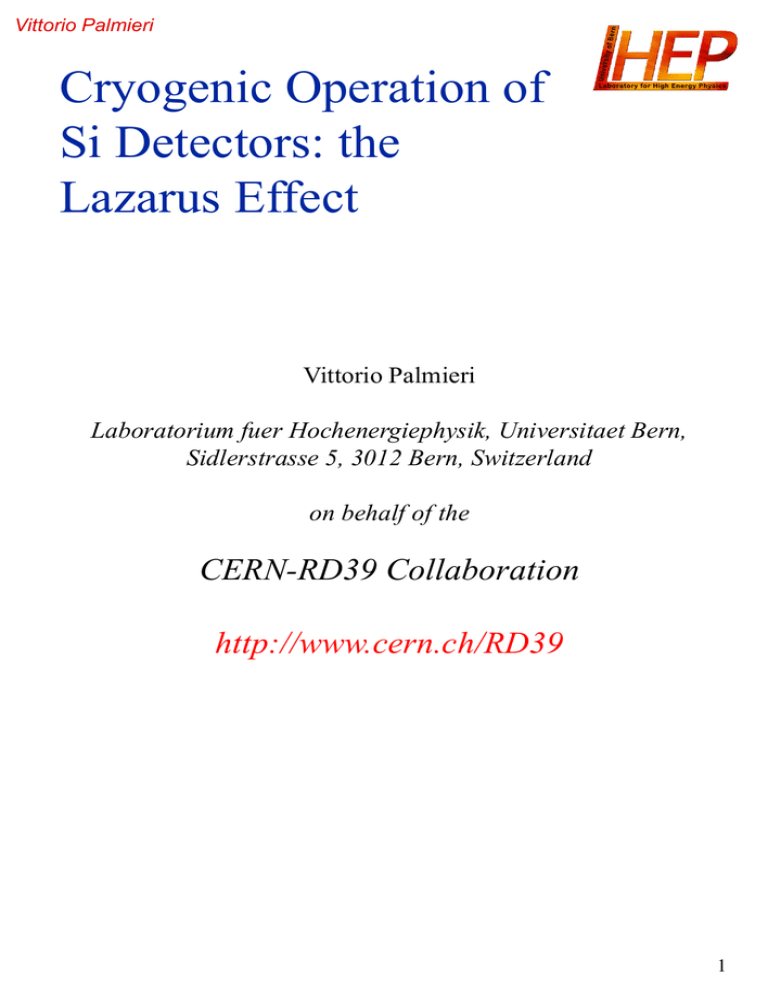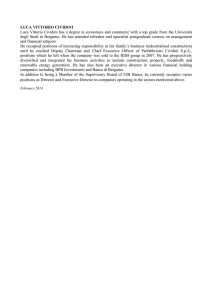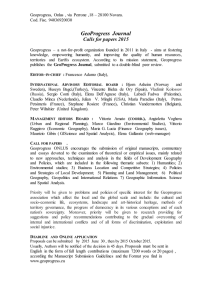Radiation Hard Liquid Nitrogen Cooled Silicon Detectors
advertisement

Vittorio Palmieri Cryogenic Operation of Si Detectors: the Lazarus Effect Vittorio Palmieri Laboratorium fuer Hochenergiephysik, Universitaet Bern, Sidlerstrasse 5, 3012 Bern, Switzerland on behalf of the CERN-RD39 Collaboration http://www.cern.ch/RD39 1 Vittorio Palmieri Outline • Properties of Si at cryogenic temperatures • CCE of heavily irradiated Si detectors at cryogenic temperatures: • 1014 n/cm2 • 1015 n/cm2 • Neutralization of induced defects: the Lazarus effect • Low cost “ohmic” devices • Segmented devices: irradiated DELPHI module (5 1014 n/cm2) • Low mass cooling • Conclusions • Future trends 2 Vittorio Palmieri Properties of Silicon at Cryogenic Temperatures C. Canali et al., Phys. Rev. B 12 (1975) 2265 G. Ottaviani et al, Phys. Rev. B 12 (1975) 3318 3 Vittorio Palmieri Radiation Hardness of Silicon at 300 K E. Borchi et al., Nucl. Phys. B (Proc. Suppl.) 61B (1998) 481 The ROSE Collaboration (RD48) Status Report, CERN/LHCC 97-39 1997 4 Vittorio Palmieri 1.2 1014 n/cm2 Irradiated Si Detectors Operated at 4.2 K, 77 K and 195 K • Irradiated at room temperature at TAPIRO, ENEA Italy • Stored at room temperature and bonded, therefore fully reverse annealed (RA) • Material and process: – Al/n+/n/p+/Al 1.8 kW-cm 5 Vittorio Palmieri I-V Characteristic 1.2 1014 n/cm2 RA 6 Vittorio Palmieri M.I.P.s Signal Charge and Timing 77 K 50 V C. Da Via’ et al., Proc. of the International Conference on GaAs, Nucl. Instr. and Meth. in Phys. Res. A (1998) in press 7 Vittorio Palmieri Charge Collection Efficiency 1.2 1014 n/cm2 RA C. Da Via’ et al., Proc. of the International Conference on GaAs, Nucl. Instr. and Meth. in Phys. Res. A (1998) in press 8 Vittorio Palmieri 2.2 1015 n/cm2 Irradiated Si Detectors Operated at 4.2 K, 77 K and 195 K • Irradiated at room temperature at TRIGA, JSI Slovenia • Stored at room temperature and bonded therefore fully reverse annealed (RA) • Different materials and processes: – Al/n+/n/p+/Al 1.8 kW-cm O2 – Al/n+/n/p+/Al 2.7 kW-cm 9 Vittorio Palmieri I-V Characteristic 2.2 1015 n/cm2 RA 300K I-V 300K I-V 0.E+00 -12 -10 -8 -6 -4 -2 1.E-05 0 -5.E-05 1.E-05 -1.E-04 Current (A) -2.E-04 -3.E-04 Current (A) 8.E-06 -2.E-04 6.E-06 4.E-06 -3.E-04 2.E-06 -4.E-04 0.E+00 -4.E-04 0 0.2 Voltage (V) 0.4 0.6 0.8 1 Voltage (V) 77K I-V 1.E-08 8.E-09 6.E-09 Current (A) 4.E-09 2.E-09 -100 -80 -60 -40 0.E+00 -20 -2.E-09 0 20 40 60 80 100 -4.E-09 -6.E-09 -8.E-09 -1.E-08 Voltage (V) 10 Vittorio Palmieri M.I.P.s Signal Charge and Timing 77 K 250 V V.G. Palmieri et al., Nucl. Instr. and Meth. in Phys. Res. A 413 (1998) 475 11 Vittorio Palmieri Charge Collection Efficiency 2.2 1015 n/cm2 RA V.G. Palmieri et al., Nucl. Instr. and Meth. in Phys. Res. A 413 (1998) 475 12 Vittorio Palmieri The Lazarus Effect St. John at al., The Bible, New Testament, ~100 13 Vittorio Palmieri Radiation Induced Defects in Silicon Ec Ef Ev Electron Traps (Vacancies Related) V6 CICS(B) VO CICS(A) V2(=/-)+Vn V2(-/0)+Vn very shallow Ec - 0.11eV Ec - 0.17eV Ec- 0.17eV Ec-0.22eV Ec-0.40eV Holes Traps (Interstitial Related) 0.38/cm 0.63 CI Ev+0.28eV 0.38 CI O I EV+0.36eV 0.96 0.96 (Disappears after annealing) 1.5 (disappears after annealing) 1.2 (depends on [Cs] and[OI]) The ROSE Collaboration (RD48) Status Report, CERN/LHCC 98-39 1998 14 Vittorio Palmieri The Lazarus Effect T = 300 K e conduction band electron trapping electron de-trapping hole trapping h hole de-trapping valence band T = 77 K e conduction band e trap filled trap filled h valence band h 15 Vittorio Palmieri The CERN RD39 Collaboration CERN/LHCC 98-27 DRDC P53 Add. 1 August 12, 1998 ADDENDUM TO PROPOSAL DRDC P53 RD39 Collaboration: Kurt Borer, Stefan Janos, Vittorio Palmieri and Klaus Pretzl, LHEP, University of Bern; Zheng Li, Brookhaven National Laboratory, USA; Eric Heijne, Carlos Lourenço, Tapio Niinikoski *, Iztok Ropotar and Peter Sonderegger, CERN, Geneva, Switzerland; Emilio Borchi, Mara Bruzzi and Silvia Pirollo, INFN and University of Florence, Italy; Sylvie Chapuy and Zlatko Dimcovski, University of Geneva, Department of Radiology, Switzerland; William Bell and Kenway Smith, Glasgow University, U.K.; Peter Berglund, Jaakko Koivuniemi and Martti Valtonen, Helsinki University of Technology, Espoo, Finland; Oleg Mukhanov, HYPRES Inc., N.Y., USA; Wim de Boer, Eugene Grigoriev and Stephan Heising, IEKP, Karlsruhe University, Germany; Luca Casagrande, LIP, University of Lisbon, Portugal; Vladimir Cindro, Marko Mikuz and Marko Zavrtanik, Jozef Stefan Institute and Dept. of Physics, University of Ljubljana, Slovenia; Cinzia Da Viá, Igor Konorov and Stephan Paul, Technical University, Munich, Germany; Salvatore Buontempo, Nicola D'Ambrosio, Valeria Granata, Sergio Pagano and Gennaro Ruggiero, INFN and University of Naples, Italy; Susumu Takada, Saitama University, Japan; Antonio Esposito, ETL, Tsukuba, Japan; Jorma Salmi, Heikki Seppä and Ilpo Suni, VTT, Espoo, Finland. co-spokesperson 16 Vittorio Palmieri Temperature Dependence 10^15 RA 250 V "reverse" 25% CCE 20% 15% 10% 5% 0% 75 95 115 135 155 175 Temperature (K) 10^15 NRA 250 V "reverse" 30% 25% CCE 20% 15% 10% 5% 0% 75 100 125 150 175 200 225 Temperature (K) Gennaro Ruggiero 17 Vittorio Palmieri Voltage Dependence 10^15 RA 77 K 70% 60% 50% CCE 40% 30% 20% 10% -250 -150 0% -50 50 150 250 150 250 Bias Voltage (V) 10^15 NRA 77 K 80% 70% 60% CCE 50% 40% 30% 20% 10% -250 -150 0% -50 50 Bias Voltage (V) Gennaro Ruggiero 18 Vittorio Palmieri 1.0 1015 n/cm2 Irradiated Si “Ohmic Device” • Irradiated at room temperature at TRIGA, JSI Slovenia • Stored at room temperature and bonded (4min @ 80C = 2weeks at 300C) therefore fully RA • Material and process: – Al/n+/n/n+/Al 5 kW-cm After irradiation Before irradiation + + + + - + 19 Vittorio Palmieri I-V Characteristic 300K I-V 300K I-V 8.E-05 0.E+00 -12 -10 -8 -6 -4 -2 0 7.E-05 -1.E-05 6.E-05 Current (A) Current (A) -2.E-05 -3.E-05 5.E-05 4.E-05 3.E-05 -4.E-05 2.E-05 -5.E-05 1.E-05 0.E+00 -6.E-05 0 2 4 Voltage (V) 6 8 10 12 Voltage (V) 77K I-V 1.E-07 8.E-08 6.E-08 Current (A) 4.E-08 2.E-08 0.E+00 -100 -80 -60 -40 -20 -2.E-08 0 20 40 60 80 100 -4.E-08 -6.E-08 -8.E-08 -1.E-07 Voltage (V) 1.0 1015 n/cm2 RA Gennaro Ruggiero 20 Vittorio Palmieri M.I.P.s Signal Charge and Timing 77 K 250 V Gennaro Ruggiero 21 Vittorio Palmieri Charge Collection Efficiency 77 K 80% 70% 60% CCE 50% 40% 30% 20% 10% -250 -150 0% -50 50 150 250 Bias Voltage (V) 1.0 1015 n/cm2 RA Gennaro Ruggiero 22 Vittorio Palmieri Liquid Nitrogen Cooling • Non-flammable • Non-toxic • Easy to handle • High cooling power • Environmentally friendly • Available everywhere 23 Vittorio Palmieri RD39/COMPASS August Test Beam RD39 cryostat COMPASS m-strips telescope muon-beam DELPHI strips 24 Vittorio Palmieri DELPHI Module hybrid mx6 n-side p-side mx6 p-side n-side Detectors: Hamamatzu 320 mm 5.75 x 3.2 cm2 3-6 Kohm cm p-side 640 strips strip pitch 25 mm r-o pitch 50 mm n-side 640 strips (p-stops) strip pitch 42 mm r-o pitch 42 mm V. Chabaud et al., CERN-PPE/95-86, 1995 Electronics:10 x MX6 128 input channels CMOS technology 2.5 MHz speed 1.5 ms peaking time s/n degrades by 8.5% for every 100Gy of noise 25 Vittorio Palmieri Irradiated (Dead) Detector Laser Scan 5 1014 p/cm2 NRA Peter Chochula and Paula Collins 26 Vittorio Palmieri Operation in the Cold 77K hybrid mx6 mx6 hybrid mx6 mx6 n-side Det 1 p-side non-irr n-side p-side p-side Det 2 n-side 5 1014p/cm2 beam Temperature (K) 2nd module on ! T hybrid D1 T hybrid D2 T bath Time (s) William Hamish Bell and Luca Casagrande 27 Vittorio Palmieri Back from the Dead Luca Casagrande and Paula Collins 28 Vittorio Palmieri Temperature and Voltage Dependence 30V 110K T 90V 110K V 90V 125K Luca Casagrande and Paula Collins 29 Vittorio Palmieri Liquid Nitrogen Low Mass Cooling • Cooling must be taken as an integral part of engineering (not an add-on) • Power must be absorbed where it is produced – detector: < 1 µW/cm2 – read-out: ~ 3 mW/strip • Support structures: conduction is negligible if cooling is integrated • Vacuum isolation is needed for a reliable low-mass system 30 Vittorio Palmieri RD39 Module Tapio Niinikoski 31 Vittorio Palmieri Conclusions • Cryogenic cooling dramatically improves radiation hardness of silicon detectors •After 1014 n/cm2 irradiation 100% CCE is achieved with only 50 V detector bias •After 1015 n/cm2 irradiation a m.i.p., most probable signal of 13000 e, is measured at 200 V detector bias. This corresponds to 50% CCE •No difference is found between room temperature and 195 K operation •Detectors storage at room temperature slightly affect the results (many months) •Cooling needed only during operation •Similar results apply to segmented devices 32 Vittorio Palmieri Future Trends •Low mass cooling system for a full tracker (2 geometry) under construction •Ohmic detectors could result in a much cheaper and more reliable solution •Need for evaluation of performances of irradiated and non-irradiated FET electronics at cryogenic temperatures 33







